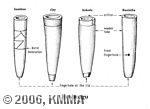




Other name: obusheegu
The ensheegu is a conical side-blown whistle. The underside is open and can be used as a finger hole, with the left index finger, to produce a different note. The ensheegu is usually not decorated; in rare instances the ones made of bamboo have geometric designs pyrographed in the sides.
The instrument is held vertically to the mouth between the thumb and the index finger of both hands. The player blows along the upper edge of the instrument and can produce two notes. The ensheegu is always played in a group. These ensembles are usually made up of three flutes of different sizes, giving three different pitches (high, middle and low). Sometimes the ensemble is larger and the ambitus is then also greater. The melodic and rhythmic patterns that can be produced by each player are always limited to one or two notes, played in a hoketus style, in which melodic and rhythmic patterns are intermingled. The ensheegu with the highest note is played by the leader of the ensemble, who has more room to improvise and leads the ensemble. The three categories of ensheegu each have their own specific name, which varies depending on the region.
The most nimble ensembles combine this style of playing with all kinds of movements: they jump, roll on the ground and dance whilst still being able to continue to play with precision. Sometimes there is also a kind of jester who adds to the performances with comical gestures.
The combinations within which the ensheegu is played can vary considerably, as some play it only solo and instrumentally, whilst others combine it with singing and even with drums.
The ensheegu used to be played in honour of the king and the royal drums of Igara, Buhweju, Buzimba and Ankole and to add lustre to certain ceremonies. Now that the traditions of the kingdoms have disappeared, the ensheegu has lost some of its importance, but it is still played during festivities.
Apart from differentiation in the pitch, there are four different categories of ensheegu in Ankole. The first type is made of bamboo, is only conical on the underside, measures 12 to 15 cm in length, has pyrographed decorations and occurs in Igara. The second type is made of clay, has a cow oesophagus wound around it to strengthen it, measures 9.5 cm and also occurs in Igara. The third type is the royal ensheegu of Ankole, which is a series of 13 bamboo flutes measuring 16 to 19 cm in length, has a cow oesophagus or a piece of hide of the monitor lizard wound around it to keep the two hollow pieces of bamboo together. The fourth type was used by the royal ensheegu of the former Buzimba, an ensemble of six bamboo flutes, which unfortunately no longer exist as they were lost in a fire. They had a finger-hole in the side of the pipe and were made of one single piece of bamboo.
for more information see also: VAN THIEL, Paul, "Multi-Tribal Music of Ankole. An ethnomusicological study including a glossary of musical terms." Edited by the Royal Museum for Central Africa, Annales, Sciences Humaines, nr 91, 1977, 234 pp.
© KMMA/Paul VAN THIEL